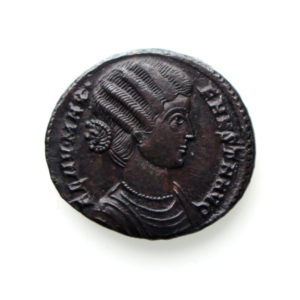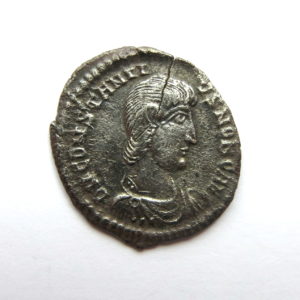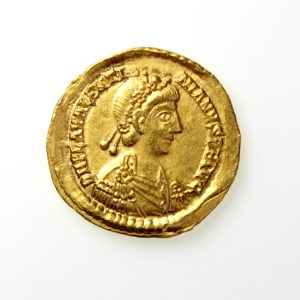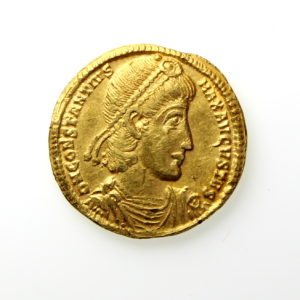Constantius I, as Caesar, AV Medallion of Ten Aurei (reproduction)
£5,500.00
Constantius I, as Caesar, AV Medallion of Ten Aurei (reproduction). Unknown maker, circa 20th century, copying an issue of Treveri, circa AD 297-305. FL VAL CONSTANTIVS NOBIL CAES, laureate, draped and cuirassed bust to right / REDDITOR LVCIS AETERNAE, prince on horseback to right, holding spear, advancing towards city of London represented as a gate with two towers before which a female figure kneels in supplication with LON below, below the horse, galley to right on waves (the Thames), with four rowers; PTR in exergue. For prototype cf. RIC VI 34, p. 167; J. Babelon and A. Duquénoy, ‘Médaillons d’or du Trésor ď Arras; L’entrée de Constance Chlore à Londres en 296 après J.-C’ in Arethuse (Jan. 1924); cf. G. F. Hill ‘Roman coinage in London’, in An Inventory of the Historical Monuments in London, Volume 3, Roman London (London, 1928), note 5 and pl. 67; cf. P. Bastien and C. Metzger, Le trésor de Beaurains, dit d’Arras in Mémoires de la Commission départementale des monuments historiques du Pas-de-Calais (Wetteren: Éditions Numismatique romaine), 1977, no. 218. 52.87g, 39mm, 12h.
The Arras Museum holds the original “London medallion” that this piece reproduces. It was found as part of a hoard at Beaurains, near Arras, on 21st September 1922. Some of the gold from the hoard was melted down, some coins were sold to the city of Arras and some were kept by the workers who discovered the hoard and then dispersed. As such it is difficult to be certain of the original size of the hoard although Pierre Bastien estimated that there were originally 700 coins or medallions. (see Bastien and Metzger, Le trésor de Beaurains dit d’Arras, p. 25, 193-194). Arthur Evans informs us that the “London medallion” was only saved from being melted down “by the conscientious scruples of its possessor. The labourer to whose share it had fallen was to such an extent afflicted with doubts as to how far he was its rightful owner that he consulted his father confessor, who lived on the Belgian side of the frontier. The priest, on religious grounds, bade him take it back to his employer, and this important piece was thus saved from the melting-pot. This remarkable medallion may truly be said to supply the most valuable existing memorial of the important place that London occupied in the Roman Empire at the end of the third century.” (A. Evans, “Some Notes on the Arras Hoard: Inception of Solidus Standard on British Model in Medallions of Constantius Chlorus” in The Numismatic Chronicle and Journal of the Royal Numismatic Society, vol. 10, no. 39 (1930), p. 225).
The reserve of the medallion represents Constantius I’s campaign in Britain as recorded in the panegyric for Constantius in which Constantius invades Britain and defeats Allectus, and his soldiers later save the city of London from Frankish mercenaries (see Panegyrici Latini (VIII): Panegyric of Constantius).
A series of cast copies of the medallions from the Arras Hoard were made by M. Etienne Bourgey in the 1920s. Unlike Bourgey’s reproductions, this piece is stamped with an “R” on the obverse and does not match the flan shape of the original therefore it is unlikely to be part of that series.
Out of stock












